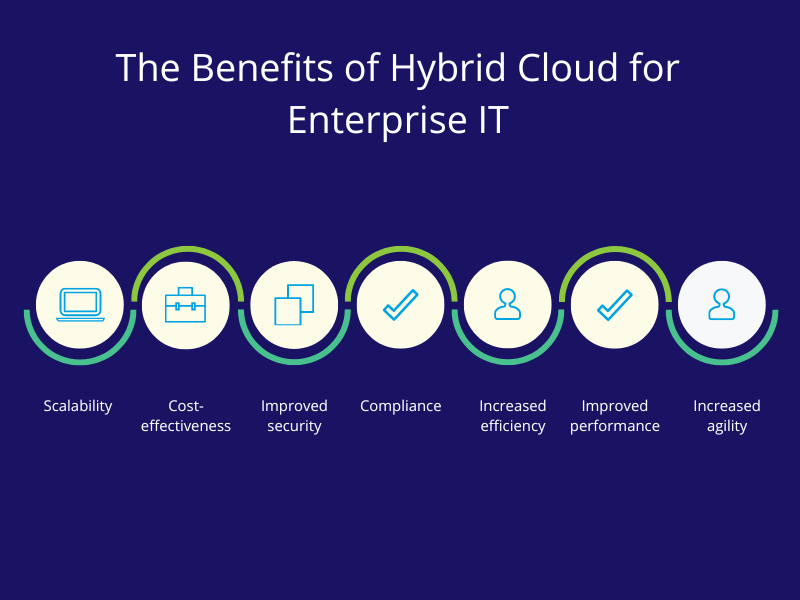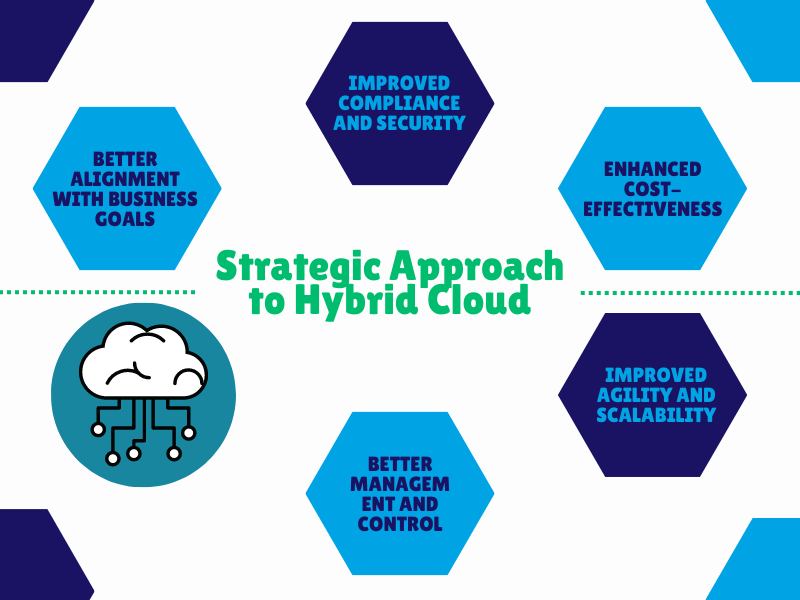The evolution of technology has dramatically changed the way businesses operate. With the increasing demand for faster, more flexible, and cost-effective IT solutions, the use of cloud computing has become widespread. While public cloud solutions offer cost-effectiveness and scalability, many organizations still struggle with privacy and compliance concerns. On the other hand, private clouds provide better control over data, but are often more expensive and less flexible.
This is where the hybrid cloud model comes in. A hybrid cloud combines the best aspects of public and private clouds to deliver a solution that balances performance, cost, and compliance. By using a strategic hybrid cloud, organizations can improve their performance, ensure better data regulation, and realize the full potential of their IT investments.
In this article, we will explore the benefits of using a strategic hybrid cloud in enterprise IT and the best practices for implementing and managing this solution. We will also discuss the common challenges organizations face when adopting a hybrid cloud and how to overcome them. With this information, organizations can make an informed decision about whether a hybrid cloud is right for them and how to make the most of this solution.
A hybrid cloud combines public cloud computing resources with private cloud services in order to achieve optimal performance, scalability, and data regulation for enterprise IT systems. The public cloud is used for applications that require less stringent security measures, such as web hosting or software development platforms. The private cloud is used for applications that require more secure computing environments, such as financial transactions processing or customer relationship management (CRM) systems
Understanding the Hybrid Cloud Model
The hybrid cloud model is a combination of both public and private cloud computing, allowing organizations to use multiple cloud environments to meet their specific needs. This approach to cloud computing provides organizations with the flexibility to choose the best environment for each workload, balancing the need for performance, security, and cost-effectiveness.
In a hybrid cloud environment, some workloads may be run in a public cloud environment for the scalability and cost-effectiveness it provides, while sensitive data may be stored and processed in a private cloud environment for enhanced security. By using a combination of cloud environments, organizations can enjoy the best of both worlds, delivering the performance and scalability of public cloud computing with the security and control of private cloud computing.
Additionally, a hybrid cloud environment can also help organizations maintain compliance with regulations and standards, as they can ensure that sensitive data is stored and processed in a secure and compliant environment.
Overall, the hybrid cloud model is becoming increasingly popular among organizations looking to improve the efficiency and performance of their IT operations while ensuring the security and regulation of their data. By leveraging the strengths of both public and private cloud computing, organizations can achieve their goals and stay ahead of the competition.
The Benefits of Hybrid Cloud for Enterprise IT

- Scalability: Hybrid cloud allows organizations to scale their IT infrastructure up or down as needed, providing them with the flexibility to quickly respond to changing business needs and demands.
- Cost-effectiveness: By utilizing the public cloud for non-sensitive workloads, organizations can reduce the cost of maintaining their IT infrastructure, as public cloud providers typically offer lower costs than traditional IT.
- Improved security: Sensitive data can be stored and processed in a private cloud environment, providing enhanced security and control over sensitive information.
- Compliance: A hybrid cloud environment can help organizations maintain compliance with regulations and standards, as they can ensure that sensitive data is stored and processed in a secure and compliant environment.
- Increased efficiency: By utilizing the strengths of both public and private cloud computing, organizations can streamline their IT operations and reduce the time and resources required to manage their infrastructure.
- Improved performance: Hybrid cloud environments can provide organizations with enhanced performance, as they can choose the best cloud environment for each workload, based on their specific needs and requirements.
- Increased agility: The hybrid cloud model allows organizations to respond quickly to changing business needs and demands, increasing their agility and competitiveness.
Balancing Performance and Compliance in a Hybrid Cloud Environment
- Define Compliance Requirements: The first step in balancing performance and compliance in a hybrid cloud environment is to clearly define the compliance requirements for each workload. This will help organizations determine which workloads can be run in the public cloud and which workloads need to be run in the private cloud.
- Choose the Right Cloud Environment: Organizations should choose the right cloud environment for each workload, based on their specific needs and requirements. For example, sensitive workloads may need to be run in the private cloud for enhanced security and control, while non-sensitive workloads may be run in the public cloud for scalability and cost-effectiveness.
- Implement Strong Security Measures: Organizations should implement strong security measures to protect their data in both the public and private cloud environments. This may include encryption, access controls, and monitoring and detection systems.
- Use a Centralized Management System: By using a centralized management system, organizations can better manage and control their hybrid cloud environment, ensuring that performance and compliance requirements are met.
- Continuously Monitor and Assess: Organizations should continuously monitor and assess their hybrid cloud environment to ensure that performance and compliance requirements are being met. This will help organizations detect and resolve any issues quickly, minimizing the risk of data breaches or compliance violations.
By balancing performance and compliance in a hybrid cloud environment, organizations can ensure that their IT operations are secure, efficient, and cost-effective. By adopting a strategic approach to hybrid cloud, organizations can maximize the benefits of hybrid cloud computing and stay ahead of the competition.
The Importance of a Strategic Approach to Hybrid Cloud
A strategic approach to hybrid cloud is crucial for organizations seeking to maximize the benefits of hybrid cloud computing, while balancing performance and compliance requirements. The hybrid cloud model provides organizations with the flexibility to run their workloads in the most appropriate environment, whether it be in the public cloud, private cloud, or a combination of both. However, without a strategic approach, organizations may not be able to fully realize the benefits of hybrid cloud computing.
- Better Alignment with Business Goals: A strategic approach to hybrid cloud helps organizations align their IT operations with their business goals. By choosing the right cloud environment for each workload, organizations can ensure that their IT operations support their business objectives and deliver the performance and capabilities required for their operations.
- Improved Compliance and Security: A strategic approach to hybrid cloud can help organizations improve their compliance and security posture. By clearly defining their compliance requirements, organizations can ensure that their sensitive data is stored and processed in a secure and compliant environment.
- Enhanced Cost-Effectiveness: A strategic approach to hybrid cloud can also help organizations achieve enhanced cost-effectiveness. By running their workloads in the most appropriate cloud environment, organizations can minimize costs and achieve a more cost-effective IT infrastructure.
- Improved Agility and Scalability: A strategic approach to hybrid cloud can also help organizations improve their agility and scalability. By having the flexibility to run their workloads in the public or private cloud, organizations can quickly and easily scale their IT operations to meet changing business requirements.
- Better Management and Control: A strategic approach to hybrid cloud also provides organizations with better management and control over their IT operations. By using a centralized management system, organizations can better manage and control their hybrid cloud environment, ensuring that performance and compliance requirements are met.

Best Practices for Implementing and Managing a Hybrid Cloud
- Assess Business Requirements: Before implementing a hybrid cloud, organizations should assess their business requirements to determine the right cloud environment for each workload. This will help organizations ensure that their IT operations align with their business goals and deliver the performance and capabilities required for their operations.
- Define Compliance Requirements: Organizations should clearly define their compliance requirements to ensure that their sensitive data is stored and processed in a secure and compliant environment.
- Choose the Right Tools: Organizations should choose the right tools to manage their hybrid cloud environment, including a centralized management system and tools for monitoring and reporting.
- Establish Governance Processes: Organizations should establish governance processes to manage their hybrid cloud environment and ensure that performance and compliance requirements are met.
- Continuously Monitor and Optimize: Organizations should continuously monitor their hybrid cloud environment and optimize their IT operations to ensure that they are delivering the performance and capabilities required for their operations.
- Invest in Skills and Training: Organizations should invest in skills and training to ensure that their IT staff have the knowledge and expertise to effectively manage their hybrid cloud environment.
- Plan for Disaster Recovery and Business Continuity: Organizations should plan for disaster recovery and business continuity to ensure that their IT operations are protected in the event of an unexpected outage.
Overcoming Common Challenges in Hybrid Cloud Adoption
- Integration: Integrating different cloud environments can be complex, and organizations must ensure that their hybrid cloud environment is seamless and integrates with existing systems and processes.
- Security: Ensuring the security of sensitive data in a hybrid cloud environment can be challenging, and organizations must implement strong security measures to ensure the protection of their data.
- Compliance: Ensuring compliance with various regulations and standards can be difficult in a hybrid cloud environment, and organizations must implement a robust compliance program to ensure that their IT operations are compliant.
- Cost: Implementing a hybrid cloud environment can be expensive, and organizations must carefully manage their costs to ensure that they are getting the best value for their investment.
- Managing Complexity: Managing a hybrid cloud environment can be complex, and organizations must have the right tools, processes, and skills to effectively manage their environment.
- Adopting New Technologies: Organizations must be willing to adopt new technologies to fully realize the benefits of the hybrid cloud, and must have the resources and capabilities to adopt these new technologies effectively.
- Lack of Skills and Expertise: Organizations must invest in the development of skills and expertise to ensure that their IT staff are equipped to effectively manage their hybrid cloud environment.
To overcome these challenges, organizations should adopt a strategic approach to hybrid cloud adoption that includes the assessment of business requirements, the definition of compliance requirements, the selection of the right tools, the establishment of governance processes, the continuous monitoring and optimization of their environment, the investment in skills and training, and the planning for disaster recovery and business continuity. With the right approach, organizations can successfully adopt a hybrid cloud and fully realize the benefits of this powerful technology.
Realizing the Full Potential of a Hybrid Cloud for Enterprise IT
In order to realize the full potential of a hybrid cloud for enterprise IT, organizations must have a clear understanding of their business requirements, and the right strategies, processes, and tools in place. Here are some key steps that organizations can take to ensure that they are getting the most out of their hybrid cloud environment:
- Assess Business Requirements: Start by assessing your organization’s business requirements and determining which applications and services are critical to your business operations. This will help you identify the right mix of cloud environments that will meet your needs and help you get the most out of your hybrid cloud environment.
- Implement Compliance and Security Measures: Ensure that your hybrid cloud environment is secure and compliant with all relevant regulations and standards. Implement security measures such as encryption, access controls, and data backup and recovery to ensure that your data is protected.
- Choose the Right Tools: Select the right tools to manage your hybrid cloud environment, including tools for automation, orchestration, and cost management. Make sure that these tools are integrated with your existing systems and processes, and can effectively manage your hybrid cloud environment.
- Develop a Governance Strategy: Establish a governance strategy that includes policies, processes, and controls to ensure that your hybrid cloud environment is properly managed and optimized. This will help you ensure that your IT operations are aligned with your business objectives, and that your hybrid cloud environment is running smoothly and efficiently.
- Continuously Monitor and Optimize: Continuously monitor and optimize your hybrid cloud environment to ensure that it is running at peak performance. This will help you identify and resolve any issues, and ensure that your environment is running smoothly and efficiently.
- Invest in Skills and Training: Invest in the development of skills and expertise to ensure that your IT staff are equipped to effectively manage your hybrid cloud environment. This will help you ensure that your hybrid cloud environment is running at peak performance and that your staff are equipped to support your business operations.
- Plan for Disaster Recovery and Business Continuity: Ensure that you have a disaster recovery and business continuity plan in place to ensure that your hybrid cloud environment is protected against potential risks. This will help you ensure that your business operations continue in the event of an outage or disaster.
By taking these steps, organizations can realize the full potential of their hybrid cloud environment and get the most out of this powerful technology. With the right approach, a hybrid cloud can help organizations improve performance, enhance data regulation, and support their business operations effectively and efficiently.
Table: Hybrid Cloud vs Traditional IT: Key Differences and Benefits
Table: Hybrid Cloud vs Traditional IT: Key Differences and Benefits
Hybrid Cloud vs Traditional IT: Key Differences and Benefits
| Hybrid Cloud | Traditional IT |
|---|---|
| Flexibility | Limited Flexibility |
| Scalability | Limited Scalability |
| Cost Savings | Higher Cost |
| On-Demand Resource Allocation | Fixed Resource Allocation |
| Improved Performance | Potential Performance Issues |
| Enhanced Data Regulation | Potential Compliance Issues |
| Increased Agility | Slow Adaptability |
| Improved Disaster Recovery and Business Continuity | Limited Disaster Recovery and Business Continuity |
The hybrid cloud model offers a number of key benefits over traditional IT, including increased flexibility, scalability, and cost savings. With a hybrid cloud, organizations can allocate resources on-demand, which enables them to respond quickly to changing business needs. This, in turn, can lead to improved performance, enhanced data regulation, and increased agility.
In contrast, traditional IT is typically limited in terms of flexibility and scalability, which can lead to performance issues, compliance challenges, and slow adaptability. Additionally, traditional IT is often more expensive than a hybrid cloud environment, and may have limited disaster recovery and business continuity capabilities.
By embracing a hybrid cloud approach, organizations can achieve a better balance between performance, compliance, and cost. This can help organizations achieve their business objectives more effectively and efficiently, and support their long-term success
In conclusion, the hybrid cloud model offers a powerful solution for organizations looking to improve their performance and ensure better data regulation. By combining the best aspects of public and private clouds, organizations can achieve a better balance between cost, performance, and compliance.
However, it’s important to approach a hybrid cloud implementation with a strategic plan. This includes carefully selecting the right tools and services, training staff, and continuously monitoring and optimizing the solution to meet evolving business needs.
By taking these steps, organizations can maximize the benefits of a hybrid cloud, including improved performance, enhanced data regulation, and increased agility. With a strategic hybrid cloud, organizations can stay ahead of the curve, support their long-term success, and stay competitive in today’s fast-paced business environment.


Leave A Comment